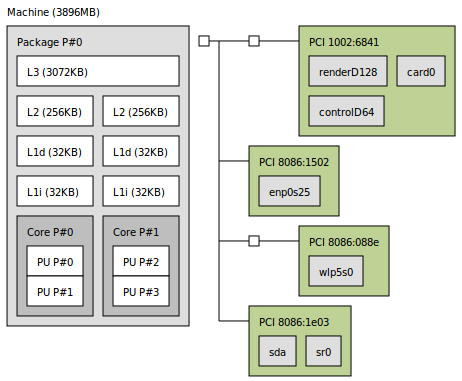I want to do block matrix-matrix multiplication with the following C code.In this approach, blocks of size BLOCK_SIZE is loaded into the fastest cache in order to reduce memory traffic during calculation.
void bMMikj(double **A , double **B , double ** C , int m, int n , int p , int BLOCK_SIZE){
int i, j , jj, k , kk ;
register double jjTempMin = 0.0 , kkTempMin = 0.0;
for (jj=0; jj<n; jj+= BLOCK_SIZE) {
jjTempMin = min(jj+ BLOCK_SIZE,n);
for (kk=0; kk<n; kk+= BLOCK_SIZE) {
kkTempMin = min(kk+ BLOCK_SIZE,n);
for (i=0; i<n; i++) {
for (k = kk ; k < kkTempMin ; k++) {
for (j=jj; j < jjTempMin; j++) {
C[i][j] += A[i][k] * B[k][j];
}
}
}
}
}
}
I searched about the best suitable value of BLOCK_SIZE and I found that BLOCK_SIZE <= sqrt( M_fast / 3 ) and M_fast here is L1 cache.
In my computer, I have two L1 cache as shown here with lstopo tool.
 Below, I am using heuristics like starting with a
Below, I am using heuristics like starting with a BLOCK_SIZE of 4 and increasing the value by 8 for 1000 times, with different values of matrix sizes.
Hopping to get the best MFLOPS ( or the least time for multiplication ) value and the corresponding BLOCK_SIZE value will be the best suitable value.
This is the code for testing:
int BLOCK_SIZE = 4;
int m , n , p;
m = n = p = 1024; /* This value is also changed
and all the matrices are square, for simplicity
*/
for(int i=0;i< 1000; i++ , BLOCK_SIZE += 8) {
# aClock.start();
test_bMMikj(A , B , C , loc_n , loc_n , loc_n ,BLOCK_SIZE);
# aClock.stop();
}
Testing gives me different values for each matrix size and do not agree with the formula.The computer model is 'Intel® Core™ i5-3320M CPU @ 2.60GHz × 4 'with 3.8GiB and here is the Intel specification
Another question :
If I have two L1 caches, like what I have in here, should I consider BLOCK_SIZE with respect to one of them or the summation of both?

lstopo. Unless you disclose the compilation details. no one can tell you more, than that a thread located for code-execution on a physical core P#0 will not benefit from any data located inside L1d belonging to P#1 physical core, so speculations on "shared"-storage start to be valid only from L3 cache ( actually not more than about ~ 3 MB small ). Also always check the actual CPU-cache associativity, cache-line sizes and all the details, that ascertain chances on using the DRAM access-latency masking by cache pre-fetches. – Supererogatory